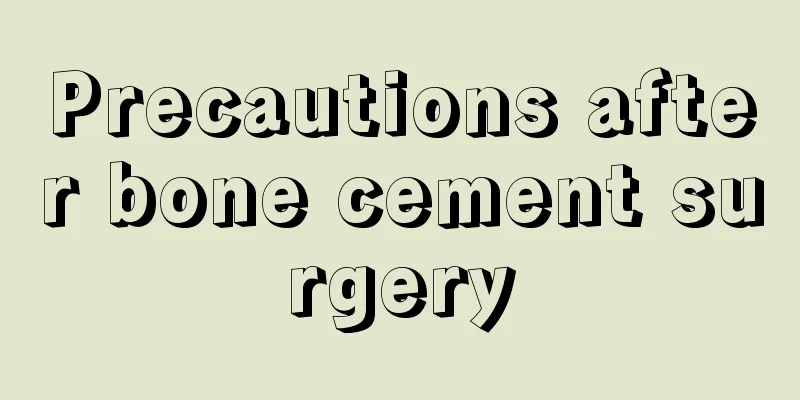Precautions after bone cement surgery

|
After the operation, you need to rest in bed for 2 to 4 weeks, after which you can go out for activities and eat more high-protein and high-calcium foods. In order to better recover the body, gradually increase activities and improve functional training. Just maintain a regular diet and rest schedule and relax. So, besides the above, what else should you pay attention to? Let's now look at the methods and steps Methods/Steps 1 Pay attention to changes in blood pressure Although lumbar bone cement surgery is a minimally invasive surgery, it also requires general or local anesthesia. Some elderly people cannot cooperate with the surgery and can only use general anesthesia. General anesthesia is risky for the elderly. Many unexpected situations may occur during and after the operation, especially a sudden drop in blood pressure. Therefore, even if the operation goes smoothly, blood pressure changes must be closely monitored after the operation, especially in the first three days after the operation. 2 Watch for changes in breathing It is very important to observe changes in breathing after surgery, especially for the elderly. The elderly have relatively weak lung function, and the suppression of breathing caused by anesthesia surgery can easily cause coughing and sputum. The sputum cannot be coughed up and blocks the respiratory tract, which can easily lead to lung infection. Early detection of breathing changes and timely measures can not only help the elderly safely pass through the critical period after surgery, but also save their lives. 3 Pay attention to high-nutrition diet Because bone cement surgery is a minimally invasive surgery, you can start eating as long as you are awake after the surgery. Eat more high-protein, nutrient-rich foods. At the beginning, you can eat more easily digestible liquid food, such as millet porridge, chicken soup, pork rib soup, fish soup, vegetable and lean meat porridge, etc. You can eat normally after two days, and you can eat sea cucumbers, yam, pork ribs, various fresh vegetables and fruits, etc. While ensuring nutrition, it is necessary to combine meat and vegetables. 4 Pay attention to moderate activity every day Lumbar bone cement surgery is a minimally invasive surgery. If the elderly person is in good physical condition and has no surgical complications, he or she can sit up within 24 hours; after 48 hours, he or she can get out of bed and stand once a day to move his or her limbs; after three days, he or she can walk with support by the bed or with the help of a walker, and gradually transition to walking on his or her own. But you must grasp the right degree, never walk too much at one time, and you must proceed step by step. 5 Pay attention to controlling underlying diseases The elderly generally have underlying diseases, such as hypertension, diabetes, coronary heart disease, etc. Anesthesia and surgery will have adverse stimulation on people. In addition, long-term bed rest can easily cause increased blood pressure, increased blood sugar, coronary heart disease attacks, etc. Therefore, blood pressure and blood sugar should be checked every day after surgery. The original regular medicines can be continued after consultation with the doctor to keep blood pressure and blood sugar within a normal range and prevent the occurrence of complications. 6 Pay attention to TCM-assisted rehabilitation The elderly have relatively weak body functions and they also have underlying diseases. Some people recover very well after bone cement surgery; some others will experience low back pain, weak legs, and inability to walk on their own. In this case, they need to go to a regular Chinese medicine hospital for rehabilitation treatment. Acupuncture on acupoints, meridian massage, etc. can be of great help to recovery. You can also take some decoctions or Chinese patent medicines to help your body recover according to your condition. 7 Pay attention to regular orthopedic check-ups If the recovery is normal after bone cement surgery, there is no need for further examination; if low back pain, leg pain, weak legs, inability to walk on your own, etc. occur, you need to go to the hospital where the surgery was performed for a CT or MRI, and then find the surgeon for further examination to confirm whether it is related to the bone cement surgery or to your own condition, and to determine further treatment plans. |
<<: Postoperative rehabilitation training for femoral head
>>: There is a bone protruding from the back of the head
Recommend
Is playing golf more likely to cause skin cancer? Check out the high-risk groups for skin cancer
Golf is a very healthy outdoor aerobic exercise, ...
Can early stage bone cancer be completely cured?
Can bone cancer be completely cured in the early ...
What should I do if my eyes hurt when looking at the phone for a long time
Eye pain from looking at the phone for a long tim...
Does non-keratinizing nasopharyngeal carcinoma cause tinnitus? What other symptoms are there?
Does non-keratinizing nasopharyngeal carcinoma ca...
What to do if you have mild heat stroke
In the summer, due to the hot weather, many peopl...
How to check pancreatic cancer
Every part of our body is related to our health. ...
Chronic pharyngitis with blood in sputum
Blood in sputum is a relatively obvious symptom o...
Will osteosarcoma recur later after recovery?
With the development of society, people's und...
Can I eat soft-shelled turtle if I have prostate cancer?
Prostate cancer is the second most common cancer ...
Does breast cancer chemotherapy require hospitalization?
Does breast cancer chemotherapy require hospitali...
Can mango and durian be eaten together?
Durian and mango are both fruits unique to southe...
Can lung cancer patients eat lychees?
Can people with lung cancer eat lychees? 1. Lung ...
Differential diagnosis of ovarian tumors
Ovarian tumor is a common tumor occurring in fema...
What are the early symptoms of endometrial cancer
In life, many patients with uterine cancer feel d...
Is papaya high in calories?
Many women who are losing weight prefer not to ea...









